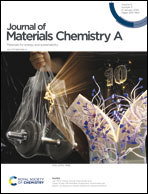A ZnO&GeSe composite electron transport layer for organic solar cells†
Abstract
In organic solar cells (OSCs), ZnO is a widely used electron transport layer (ETL), but various vacancy defects on the surface of ZnO crystals form massive trap-assisted recombination centers, which hinders electron transmission in OSCs. In this paper, a ZnO&GeSe composite is constructed by modifying ZnO with two-dimensional (2D) GeSe, and it is used for the first time as a novel ETL in OSCs, which reduces the defect density on the ZnO surface and improves the electron extraction efficiency in OSCs. The results of first-principles calculations show that GeSe can deposit additional electrons on the surface of ZnO, which stabilizes the ZnO polar surface and reduces the formation of spontaneous defects on the ZnO polar surface. The electric dipole moment formed at the interface also promotes electron transport in OSCs. The power conversion efficiency (PCE) of OSCs based on PBDB-T:ITIC and PM6:Y6 active layers increases from 10.06% and 15.20% to 11.68% and 17.51%, respectively. Meanwhile, the OSC with the ZnO&GeSe composite ETL possesses good stability compared to the device with the pure ZnO ETL. This study shows that 2D GeSe has a good application prospect as a charge transport layer, and provides an idea for the defect modification of ZnO and other semiconductor crystals by 2D materials.



 Please wait while we load your content...
Please wait while we load your content...